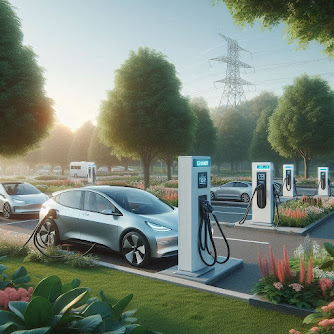🏍Electric Vehicles (EVs)
🏍Electric Vehicles (EVs)
In recent years, India has witnessed a surge in greenhouse gas emissions and fuel prices, impacting both the environment and daily expenses. To address these challenges, automobile companies and startups are increasingly shifting towards electric vehicles (EVs) as a cleaner, more cost-effective alternative.
🚘 What Are Electric Vehicles?
An Electric Vehicle (EV) uses one or more electric motors for propulsion, powered by energy stored in batteries. Unlike internal combustion engines, EVs do not burn fuel or release harmful emissions.
They are:
Mechanically simpler
More durable
Highly efficient
Environmentally friendly
India’s push for cleaner transportation is reflected in efforts to move toward EVs, but challenges remain—including battery safety, infrastructure, and cost.
Benefits of EVs 🌟
- Eco-Friendly 🌿: EVs produce zero tailpipe emissions, reducing air pollution significantly.
- Runs on Renewable Energy ⚡️: EVs can be charged using solar, wind, or other renewable sources.
- Less Noise Pollution 🗣️: Electric motors are quiet, leading to more peaceful cities and neighborhoods.
- Low Maintenance 🔧: Fewer moving parts mean fewer breakdowns and lower repair costs.
- Government Support 🏛️: Many governments offer tax incentives and subsidies for EV buyers.
Challenges of EVs 🚧
- High Initial Cost 💸: EVs are still costlier upfront than traditional cars.
- Charging Station Availability 📍: Limited infrastructure makes long trips challenging.
- Longer Charging Time ⏰: Charging can take hours compared to a few minutes at the fuel pump.
- Fewer Models Available 🚗: Limited design and variant options compared to traditional vehicles.
- - Lower Driving Range 🛣️: EVs generally have a shorter range per charge than fuel-powered vehicles.
India’s EV Scenario 📈
- Low Market Share 📊: Only 2% of total vehicles sold in India are electric.
- Dominated by 2 & 3-Wheelers 🚴♀️: 95% of Indian EVs are scooters, bikes, and rickshaws.
- Policy Initiatives 📅:
- 2012: Launch of National Electric Mobility Mission Plan (NEMMP)
- 2018: New National Electric Mobility Program introduced to develop charging stations and promote EVs
- 2030 Goal: Over 30% of all vehicles to be electric
How EV Charging Works ⚡️
- EVSE 💻: Electric Vehicle Supply Equipment delivers electricity from the grid to your car battery.
- AC to DC Conversion 🔄: The electricity from the grid (AC) is converted to DC by the car’s onboard rectifier.
Battery Specification🔋:
- Lead-acid: 12V
- Lithium-ion: 400–800V
- Capacity: 40–100 kWh
- Lifespan: 15–20 years
Wireless Charging Technology 📡
- Inductive Charging 🔋: Wireless plates in the ground charge your EV without cables.
- Ideal for Taxis 🚕: Cars can charge while waiting in a queue or taxi rank.
- Fast Charging ⚡️: Superchargers can deliver DC power 10x faster than home charging.
Safety Standards in EVs 🛡️
- Prevent Unintended Movement 🚨: Clear alerts when the vehicle is in drive mode.
- Shock Protection 💥: Proper insulation, color-coded cables, and physical barriers.
- Explosion Prevention 🚒: Overcharge and over-temperature protections.
- Battery Safety (REESS) 🔒: Safe installation, road impact protection, and isolation from cabin.
Conclusion 🌟
Electric Vehicles represent a smart, sustainable future for India and the world. With ongoing improvements in technology and infrastructure, EVs are becoming a more practical and environmentally responsible choice for modern transport.



Comments
Post a Comment